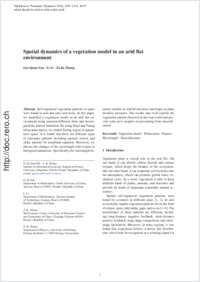Spatial dynamics of a vegetation model in an arid flat environment
- Sun, Gui-Quan Institute of Information Economy, Hangzhou Normal University, Hangzhou, China - Department of Mathematics, North University of China, Taiyuan, China
- Li, Li Department of Mathematics, Taiyuan Institute of Technology, Taiyuan, China
- Zhang, Zi-Ke Institute of Information Economy, Hangzhou Normal University, Hangzhou, China - Web Sciences Center, University of Electronic Science and Technology of China, Chengdu, China - Department of Physics, University of Fribourg, Switzerland
-
01.09.2013
Published in:
- Nonlinear Dynamics. - 2013, vol. 73, no. 4, p. 2207–2219
English
Self-organized vegetation patterns in space were found in arid and semi-arid areas. In this paper, we modelled a vegetation model in an arid flat environment using reaction-diffusion form and investigated the pattern formation. By using Hopf and Turing bifurcation theory, we obtain Turing region in parameters space. It is found that there are different types of stationary patterns including spotted, mixed, and stripe patterns by amplitude equation. Moreover, we discuss the changes of the wavelength with respect to biological parameters. Specifically, the wavelength becomes smaller as rainfall increases and larger as plant morality increases. The results may well explain the vegetation pattern observed in the real world and provide some new insights on preventing from desertification.
- Faculty
- Faculté des sciences et de médecine
- Department
- Département de Physique
- Language
-
- English
- Classification
- Ecology and biodeversity
- License
-
License undefined
- Identifiers
-
- RERO DOC 208690
- DOI 10.1007/s11071-013-0935-3
- Persistent URL
- https://folia.unifr.ch/unifr/documents/303390
Statistics
Document views: 119
File downloads:
- pdf: 242
